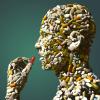Spinach contain high amounts of Ecdysteroid.
http://www.ncbi.nlm.nih.gov/pubmed/18220764Phytoecdysteroids and anabolic-androgenic steroids--structure and effects on humans.
Abstract
Phytoecdysteroids are structural analogs of the insect molting hormone ecdysone. Plants comprise rich sources of ecdysteroids in high concentration and with broad structural diversity. Ecdysteroids have a number of proven beneficial effects on mammals but the hormonal effects of ecdysteroids have been proven only in arthropods. Their structures are somewhat similar to those of the vertebrate steroid hormones but there are several structural differences between the two steroid groups. Despite of these essential structural differences, ecdysteroids exert numerous effects in vertebrates that are similar to those of vertebrate hormonal steroids, and they may serve as effective anabolic, hepatoprotective, immunoprotective, antioxidant and hypoglycemic agents. Ecdysteroids do not bind to the cytosolic steroid receptors, instead, they are likely to influence signal transduction pathways, like the anabolic steroids, possibly via membrane bound receptors. The application of phytoecdysteroids is a promising alternative to the use of anabolic-androgenic steroids because of the apparent lack of adverse effects. The prospective use of phytoecdysteroids may extend to treatments of pathological conditions where anabolic steroids are routinely applied. One of the most cited aspects of phytoecdysteroid application (on the Internet) is the increase of muscle size. However in this field too stringent research is needed as an adequate cytological explanation is not yet available for the anabolic. This paper reports on the most important structural differences between androgenic hormones, their synthetic analogs and ecdysteroids. The anabolic/hormonal effects and the possible mechanisms of action of these compounds are also discussed as concerns the skeletal muscle.
http://www.ncbi.nlm.nih.gov/pubmed/18444661 In the full-text study they say '' an equivalent of 1kg/day of Spinach ''Phytoecdysteroids increase protein synthesis in skeletal muscle cells.
Abstract
Phytoecdysteroids, which are structurally similar or identical to insect molting hormones, produce a range of effects in mammals, including increasing growth and physical performance. To study the mechanism of action of phytoecdysteroids in mammalian tissue, an in vitro cellular assay of protein synthesis was developed. In C2C12 murine myotubes and human primary myotubes, phytoecdysteroids increased protein synthesis by up to 20%. In vivo, ecdysteroids increased rat grip strength. Ecdysteroid-containing plant extracts produced similar results. The effect was inhibited by a phosphoinositide kinase-3 inhibitor, which suggests a PI3K-mediated mechanism.
http://www.ncbi.nlm.nih.gov/pubmed/20363237Ecdysteroids elicit a rapid Ca2+ flux leading to Akt activation and increased protein synthesis in skeletal muscle cells.
Gorelick-Feldman J, Cohick W, Raskin I.
Biotech Center, Cook College, Rutgers University, 59 Dudley Road, New Brunswick, NJ 08901, USA.
Abstract
Phytoecdysteroids, structurally similar to insect molting hormones, produce a range of effects in mammals, including increasing growth and physical performance. In skeletal muscle cells, phytoecdysteroids increase protein synthesis. In this study we show that in a mouse skeletal muscle cell line, C(2)C(12), 20-hydroxyecdysone (20HE), a common phytoecdysteroid in both insects and plants, elicited a rapid elevation in intracellular calcium, followed by sustained Akt activation and increased protein synthesis. The effect was inhibited by a G-protein coupled receptor (GPCR) inhibitor, a phospholipase C (PLC) inhibitor, and a phosphoinositide kinase-3 (PI3K) inhibitor.
Edited by Ichoose2live, 07 March 2011 - 07:22 AM.






















































